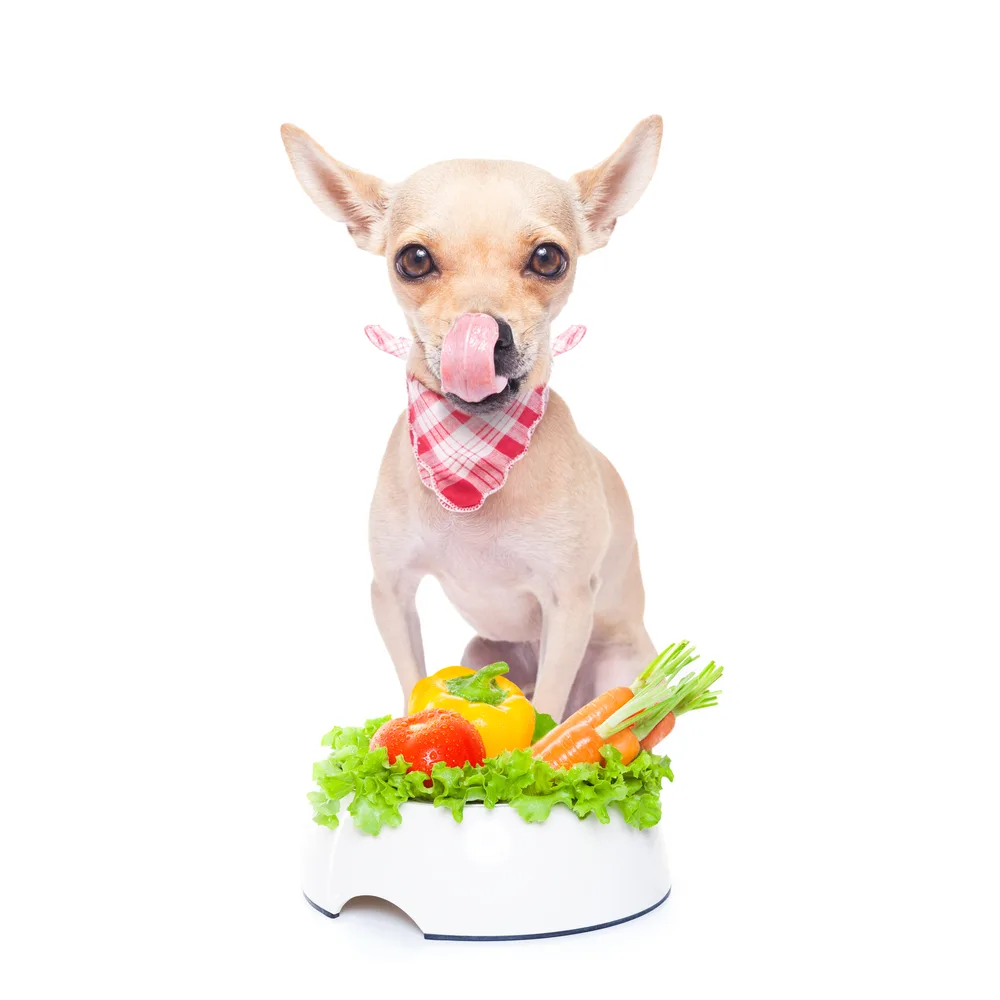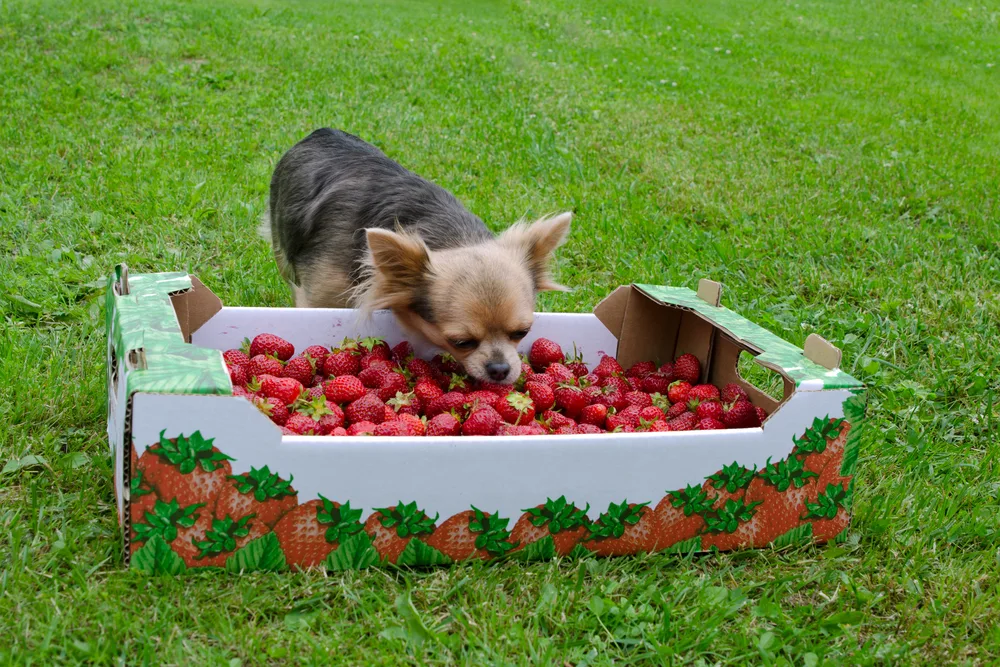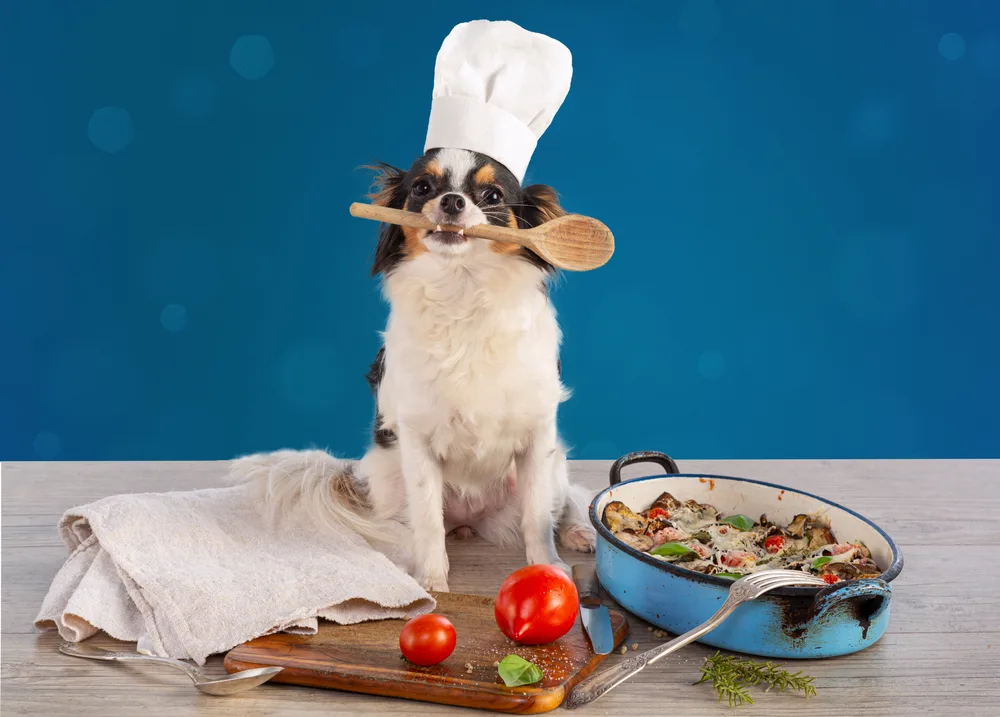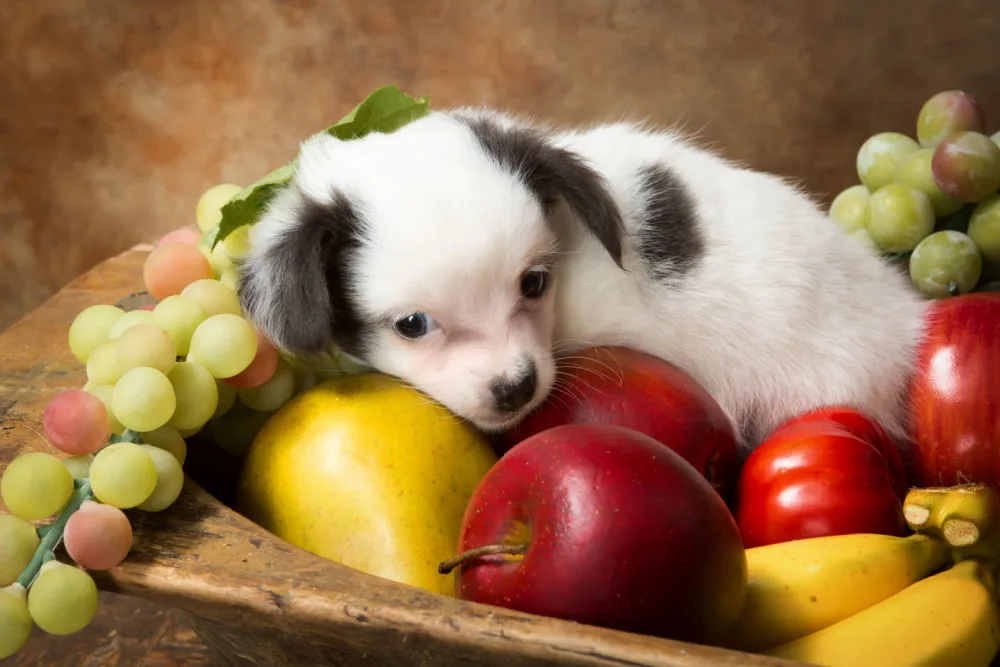A quick and natural way to improve a dog’s diet is to add vegetables and fruit. These may be added to your dog’s meals or given as a healthy snack to replace commercial dog treats.
People often think of dogs as carnivores or meat-eaters. After all, dogs are descended from wolves, and wolves have a reputation for being exclusive meat-eaters.
In reality, the wild cousins of dogs do eat plant foods and they even scavenge. They do not exclusively eat meat.
Adding vegetables, fruits, and grains to a dog’s diet is not unusual. It even makes sense. If you review the ingredients of some dog foods, you will find that fruits, vegetables, and grains are included in many of the foods.

Wolves and most other wild dogs are not strict carnivores. They are omnivores, and food from plants is a normal part of their diet. Similar to how domesticated dogs scavenge for scraps beneath the dinner table, wolves and wild dogs scavenge in addition to hunting for snacks and meals throughout their day.
Sometimes these plant foods are found in the stomach or intestines of their prey. For example, wolves eat deer that graze on grass. Other times the wolves may eat plant matter directly, as in grasses or berries.
Like wolves, dogs are also omnivores, and plant foods are not only good for them, but dogs seem to enjoy eating fruits and vegetables as well.
Vegetables and Dog Food

Most dogs seem to enjoy eating vegetables. Sometimes they prefer the vegetables as add-ins to their dog food, and sometimes the vegetables make great snacks for dogs.
Vegetables add valuable vitamins, roughage, and minerals to the diet. These are some of the vegetables that dogs seem to enjoy the most:
- Carrots
- Peas
- Corn
- Green Beans
- Zucchini
We do have a comprehensive list of safe veggies for dogs to eat and what veggies to avoid.
Dogs especially like carrots (mine don’t, but most do). They enjoy chewing on whole raw carrots and seem to like the crunch.
Not only are they a low-calorie snack, but they also help clean dogs’ teeth and gums. Carrots can also be grated up and added to a dry dinner for extra moisture, texture, and flavor.
Peas and corn have a sweetness that dogs seem to favor. These vegetables need to be cooked first, with no salt or seasoning, then they may be mixed into dry or canned foods to offer interesting flavor, and to boost nutrition and fiber content.
Some dogs even like them frozen, straight from the freezer, as a fun summertime snack. Others enjoy corn on the cob and often will want to eat the cob along with the kernels. Since dogs do not easily digest corn kernels, this may actually boost the nutritional value of corn and add roughage.
However, corncobs have caused life-threatening intestinal blockages, so they should not be given without active adult supervision, or more ideally to be on the safe side, they should not be given at all.
Green beans are a favorite vegetable for some dogs (my dogs love them), and veterinarians encourage adding green beans as part of a weight-loss diet. Simply replace part of your dog’s serving of dry food with green beans to help them still feel full while simultaneously cutting extra calories.
Most dogs prefer them cooked, but some seem to like them raw.
Zucchini is another vegetable that dogs enjoy added to food, both cooked and grated up raw.
Potatoes, alfalfa sprouts, and chopped parsley are some other vegetables that work well to supplement diets.
Vegetables to be avoided are onions and garlic, which contain a toxic ingredient that can sicken dogs with vomiting and diarrhea.
Fruit in a Dog’s Diet

Many dogs enjoy sweet foods, and dog-safe fruits can be a healthy way to satisfy that sweet tooth.
You can find a full list of dog-safe fruits and fruits not to give to dogs.
- Dried fruits such as figs, dates, and prunes are good natural sources of potassium. Use caution when searching for dried fruits; choose plain freeze-dried fruits, not sweetened or flavored dried fruits.
- Fresh fruits most often enjoyed by dogs are apples, berries, and melons.
- Fruits are best given in small amounts as an occasional snack. Large amounts of fruit may cause digestive upset.
- For best digestion, give these foods separately from the main diet.
- Fruits to avoid are grapes and raisins which are toxic to dogs.
Home-Cooked Dog Foods

Home cooking your dog’s meals is a great way to control the quality of your dog’s nutrition, a major concern of many pet owners after reading news stories of dog food recalls.
There are many recipes for homemade dog foods that include grains, vegetables, and fruits, but simply adding them to prepared dog food works great as a nutritional boost.
For some dogs, a homemade diet can be a step toward improving a dog’s itchy skin or other skin problems.
Many people are experimenting with alternative diets for their dogs such as vegetarian diets, raw diets, grain-free diets, etc. Most dogs will tolerate an alternative diet, however, extra care must be given to the protein, calcium, and nutritional levels in the diet.
Most homemade diets require supplements such as The Missing Link to ensure that all of the dog’s nutritional needs are met.
Dogs tend to like the same foods that humans eat. They learn to beg and want to eat the same as their owners. Fruits and vegetables are a great way to give in to a dog’s craving for a wider diet and make low-calorie, conscience-clear dog treats.
Individual dogs’ tastes are unique, so testing with small portions at first helps to pinpoint those that a dog most enjoys. Typically, dogs enjoy experimenting with new foods, and owners can provide these taste treats guilt-free.
Whole grains are the best way to add fiber and even protein to create a completely natural diet. Grains definitely should be cooked.
Grains are not a natural food of the wild dog but are found partially digested in the stomachs of prey animals. As the stomach and intestines are often the first part of an animal eaten, grains (grasses) are an important part of a natural diet. Oatmeal, barley, and brown rice supply carbohydrates, vitamins, and minerals and are an inexpensive source of protein as well.
If you choose to pursue a home-cooked diet, seek guidance from a veterinarian and or dog nutritionist to ensure that your dog’s diet provides the complete nutrition that he or she needs.

Conclusion
Giving your dog good nutrition supports better health, and potentially a longer life span. Be sure to feed your dog a well-balanced diet and supplement with healthy treats such as fruits and vegetables.
Consider purchasing a food dehydrator to make healthy fruit and vegetable treats.
Do you give your dog fruits and veggies? If so let us know which ones in the comments and how you prepare them. We can all benefit from your suggestions!
Also Read:
Should you make your own dog food?


Cathy Bendzunas
Pet Blogger

Tudor
Thursday 27th of July 2023
My lab loves to taste the occasional blackberry whenever we pick some from our garden! Those are also great for nutrition.
Cathy Bendzunas
Friday 28th of July 2023
Yep, blackberries are a healthy snack, specially from the garden.
Sarwar Abdullah
Wednesday 8th of February 2023
This article provides useful information on how to boost the nutrition of dog food with vegetables and fruits. It highlights the importance of choosing the right foods and preparing them properly for dogs. Adding a variety of nutritious foods to a dog's diet can have many benefits and support their overall health and well-being. This article is a valuable resource for dog owners who are looking for ways to improve their pet's diet. Also visit this website : https://dogregion.com/
Judy Seals
Sunday 1st of January 2023
My rescue dogs seem more satisfied since I started adding about three ounces of moist homemade food to their dry dog food. Usually this is cooked ground turkey, brown rice cooked in bone broth, sweet potato, chopped broccoli, spinach, peas, shredded carrot, sometimes corn or beets, and blueberries. All three are between 45 and 75 pounds.
Cathy
Sunday 1st of January 2023
Sounds yummy Judy. I can see why they like it.
Danielle
Saturday 6th of August 2022
Well it's good to know that I've been helping my dog's nutrition all along! Oftentimes I'll chop up a carrot or some cucumber and I'll mix it into my dog's regular dry dog food along with a bit of oatmeal, organic peanut butter, and coconut oil. My Chi seems to love it, then as a treat, I will use baby carrots.
This article was very helpful in inspiring me to get more creative when it comes to my dog's meal! Especially as he's getting older, I want to make sure that his nutrition needs are met.
Cathy
Saturday 6th of August 2022
I'm glad you found it helpful Danielle although it already sounds like you are a pro at this.
Joan Powers
Saturday 6th of August 2022
I loved your article on feeding veggies. My chi loves veggies and fruits and actually prefers them over meat that I know is essential for protein I give him red kidney beans (the canned ones that I rinse off first) raw string beans, baked yams, blueberries, strawberries, dried cranberries, carrots, corn, watermelon (seedless), Kefir which does add some protien, small amounts of different cheeses although in small amounts because according to what I have read is hard for them to digest but is one of his favorites. I could go on and on but wanted to also say that I AM NOT RECOMMENDING THIS DIET FOR ANYONE JUST SHARING WHAT I DO THAT WORKS FOR MY LITTLE BEAR I ALSO TRY TO GET HIM TO EAT A CHEWABLE VITAMIN WHICH IS HARD TO DO BUT I CAN CRUSH IT INTO HIS FOOD Its easy to go on line and check if a food is safe for dogs There are plenty of websites to find out if you have a particular food that you want to try. My chi is very picky and will not eat dog food except on occasion dry kibble if used as a treat Just think about it - My feeling is that if I cannot even stand the smell of dog food why would I feed it to my dog GOOD LUCK EVERYONE
Cathy
Saturday 6th of August 2022
It sounds like you are giving your fur baby a very healthy varied diet Joan.